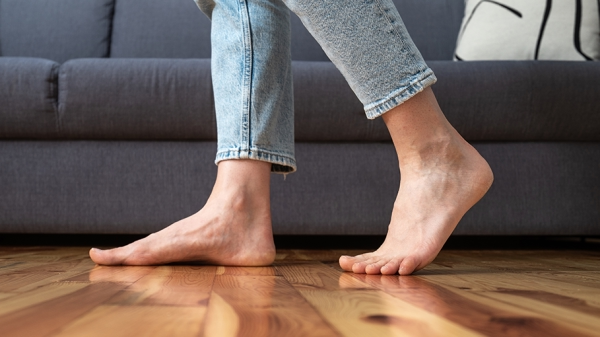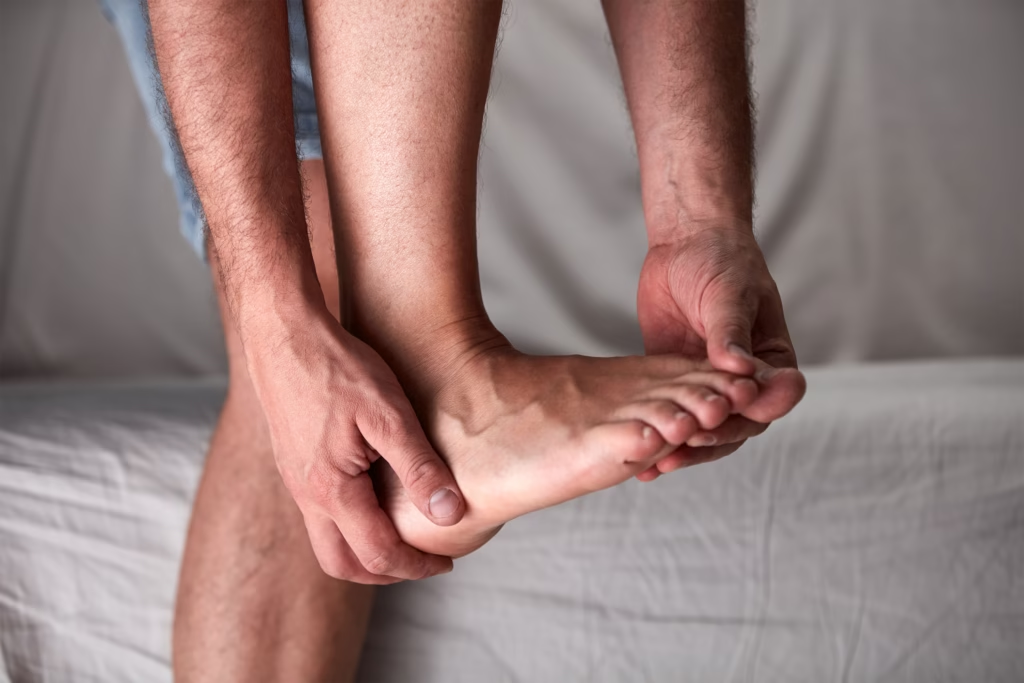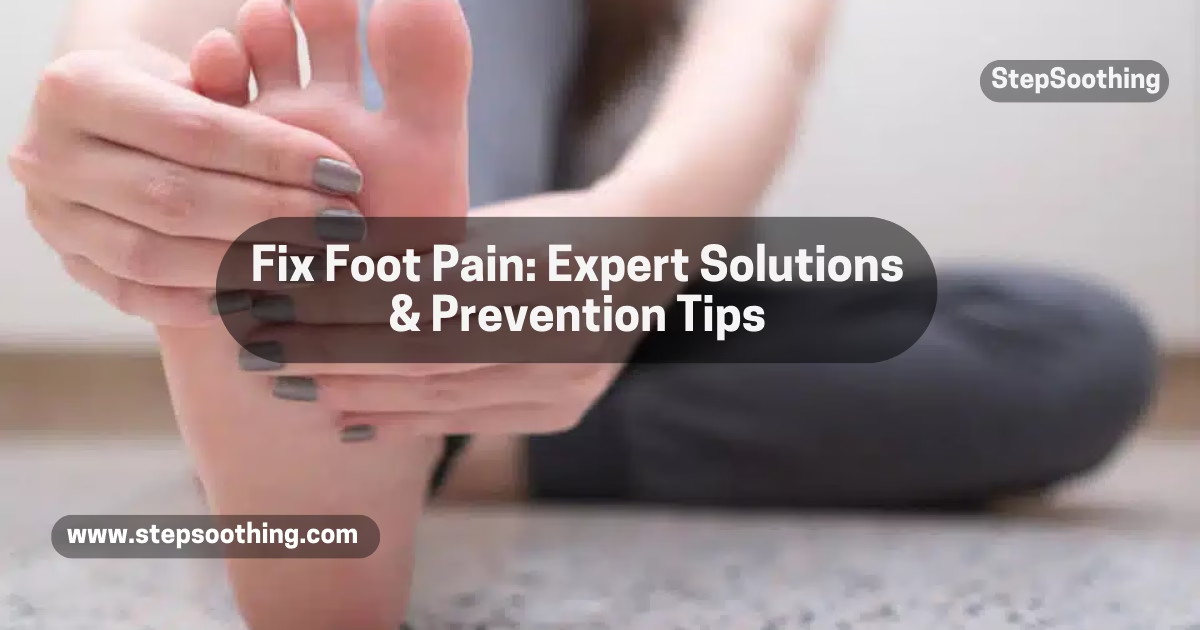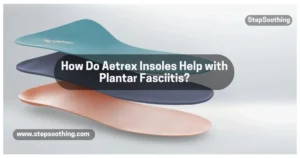Your feet are the foundation of your body, supporting you through daily activities like walking, running, and standing. Yet, foot pain affects millions, limiting mobility and diminishing quality of life. Ignoring issues like heel pain or swelling can lead to chronic disorders, joint misalignment, or even systemic health risks. Early identification, proper footwear, and targeted care are critical. As a podiatrist with over a decade of experience, I’ve seen how simple changes, like swapping narrow shoes for wide toe boxes, can transform lives. Let’s explore the most common foot problems and actionable solutions.

10 Common Foot Problems and Solutions
Plantar Fasciitis
Causes: Repetitive strain from overuse, obesity, or jobs requiring prolonged standing on hard surfaces. Weak arch support exacerbates stress on the plantar fascia.
Pain Patterns: Sharp heel pain, especially during the first steps in the morning or after rest.
Solutions:
- Arch-supportive insoles or gel heel cups to distribute pressure.
- Daily calf stretches and plantar fascia stretches (e.g., rolling a frozen water bottle under the foot).
- Night splints to keep the fascia stretched while sleeping.
Bunions
Causes: Genetics play a role, but tight/narrow footwear accelerates the big toe’s slant outward. High heels are a common culprit.
Prevention: Opt for shoes with a wide toe box and use bunion pads to reduce friction.
Solutions:
- Toe exercises (e.g., spreading toes apart) to strengthen muscles.
- Severe cases may require realignment surgery to correct the joint.
Flat Feet/Overpronation
Causes: Weak foot muscles, genetics, or injuries collapsing the arch.
Impacts: Overpronation strains knees, hips, and the lower back.
Solutions:
- Custom orthotics with firm arch support.
- Toe curls (picking up marbles with toes) and arch lifts to rebuild strength.
Heel Spurs
Causes: Calcium deposits forming due to chronic plantar fasciitis or ligament strain.
Symptoms: Dull ache in the heel when walking or standing.
Solutions:
- Cushioning insoles to absorb shock.
- NSAIDs (e.g., ibuprofen) and ice packs to reduce inflammation.
Achilles Tendinitis
Causes: Overuse in runners, tight calf muscles, or shoes lacking heel support.
Solutions:
- Heel lifts in shoes to reduce tendon strain.
- Eccentric heel drops (lowering heels slowly off a step) to promote healing.
Corns and Calluses
Causes: Friction from ill-fitting shoes or repetitive pressure.
Solutions:
- Soak feet and gently file thickened skin with a pumice stone.
- Use OTC pads with salicylic acid for stubborn corns.
Athlete’s Foot
Causes: Fungal infections thrive in damp, warm environments (e.g., sweaty socks).
Solutions:
- Keep feet dry with breathable socks and antifungal powders.
- Apply terbinafine cream daily for 2–4 weeks.
Hammertoes
Causes: Muscle imbalance from tight shoes forces toes into a claw-like position.
Solutions:
- Early-stage: Toe splints and wearing shoes with a wide forefoot.
- Severe: Surgery to release tendons or fuse joints.
Morton’s Neuroma
Causes: Nerve irritation between the third and fourth toes, often from high heels.
Solutions:
- Metatarsal pads to lift and separate toes.
- Cortisone injections for persistent pain.
Diabetic Foot Care
Causes: Neuropathy (nerve damage) and poor circulation increase ulcer risks.
Solutions:
- Inspect feet daily for cuts or redness.
- Wear specialized footwear with seamless interiors to prevent blisters.
Key Angles to Explore

Causes & Risk Factors
- Footwear: Narrow-toe shoes and high heels force toes into unnatural positions.
- Obesity: Excess weight strains arches and joints.
- Aging: Loss of fat padding increases pressure on bones.
Symptoms & Diagnosis
- Self-Check: Morning heel pain (plantar fasciitis) or visible toe deformities.
- See a Podiatrist if pain persists beyond a week or you notice numbness (a red flag for diabetic neuropathy).
Solutions & Prevention
- Footwear Guide: Choose shoes with arch support, cushioning, and a thumb’s width of space at the toe.
- Orthotics: Gel inserts for shock absorption; rigid designs for flat feet.
- Exercises: Calf stretches against a wall, resistance band workouts.
- Home Remedies: Soak feet in Epsom salt to ease soreness.
Lifestyle & Long-Term Care
- Weight Management: Losing 10 lbs. can reduce pressure on feet by 40 lbs. with each step.
- Foot Hygiene: Moisturize daily to prevent cracks; trim nails straight across to avoid ingrown edges.
Frequently Asked Questions About Common Foot Problems and Solutions
What is the most common cause of heel pain?
Heel pain is often caused by plantar fasciitis, an inflammation of the tissue connecting the heel to the toes. It’s aggravated by overuse, poor arch support, or prolonged standing.
Can bunions be reversed without surgery?
Yes! Early-stage bunions can be managed with wide toe box shoes, bunion pads, and toe-strengthening exercises. Surgery is only needed for severe deformities.
How do I know if I have flat feet?
Check your footprint: if your entire sole leaves a mark on wet ground, you likely have flat feet. Look for symptoms like arch pain or overpronation (ankles rolling inward).
Are heel spurs and plantar fasciitis the same thing?
No. Heel spurs are bony growths caused by calcium deposits, while plantar fasciitis is inflammation of the ligament. However, they often occur together.
What’s the best way to treat athlete’s foot at home?
Keep feet dry, use antifungal creams (e.g., clotrimazole), and wear breathable socks. Avoid walking barefoot in public showers to prevent reinfection.
Can tight shoes cause permanent damage?
Yes. Tight shoes can lead to hammertoes, Morton’s neuroma, and bunions. Over time, these issues may require surgery if untreated.
How can I prevent corns and calluses?
Wear properly fitted shoes, use cushioned insoles, and file thickened skin gently with a pumice stone. Moisturize daily to keep skin soft.
Is Achilles tendinitis permanent?
No. With rest, stretching, and heel lifts, most people recover fully. Ignoring it, however, can lead to chronic pain or tendon rupture.
Why do diabetics need special foot care?
Diabetes can cause neuropathy (numbness) and poor circulation, increasing risks of unnoticed injuries and infections. Daily checks and diabetic shoes are essential.
Are orthotics worth the investment?
Yes! Custom orthotics correct alignment issues, reduce strain, and prevent long-term damage. Even affordable arch-support insoles can alleviate pain from flat feet or plantar fasciitis.
Are u queries about your feet health learn more by visiting Step Soothing u will get brief information regarding shoes insole like Discover life changing Arch Support for Flat Feet, Enhancing Comfort and Shock Absorption, Improving Foot and Ankle Alignment, Felieving Foot Pain and Discomfort and much more.



